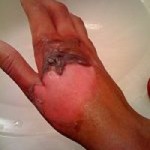 First Response’s Comments:
First Response’s Comments:
The Chef – What can happen in the kitchen: WSIB Workplace Safety Ad really hits a cord with me. Having worked in the hospitality industry for close to 20 years, I know this kind of accident can happen. What would you do if something like this happened in your workplace?Would you know what to do? Do you have an emergency response plan in place? Do you have the appropriate first aid supplies to deal with burns? Don’t forget to check out our on line store as we carry the waterjel line of burn products which are truly amazing for burns. Don’t be caught like The Chef – What Can Happen In The Kitchen!
WARNING: Graphic content. This ad is from the workplace health and safety marketing campaign from Ontario’s workers’ compensation board. Disturbingly effective.

